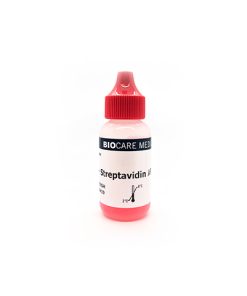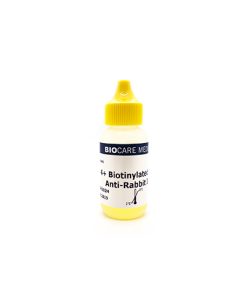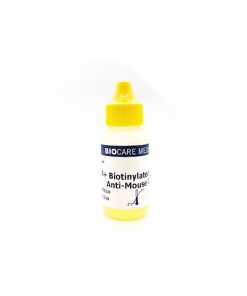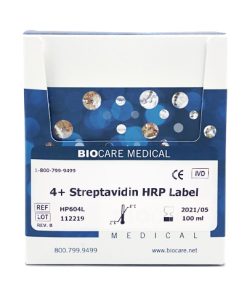4plus HRP Universal Detection
$1,616.00 – $6,585.00
Description
Product Description
Streptavidin is a protein that has similar binding properties to egg white avidin. It is isolated from streptomyces avidinii. Streptavidin has a molecular weight of 60 KD and has 4 subunits. Each subunit can bind one molecule of biotin. Biotin is a watersoluble vitamin. Streptavidin has an extremely high binding affinity (Kd=10-15) for biotin. It has proven useful in the detection of antigens coupled with biotinylated secondary antibodies. There are several advantages when using streptavidin versus an avidin complex (ABC). In contrast to avidin, streptavidin is not glycosylated and is therefore uncharged at neutral pH (6.5 versus 10). This lowers nonspecific background staining. Streptavidin also lacks carbohydrate side chains that may be another cause of non-specific background. Another key advantage of streptavidin is the significant increase in sensitivity (probably due to less steric hindrance), thus facilitating an increase in overall binding capacity. Finally, streptavidin-enzyme conjugates are much more stable than an ABC complex. The ABC complex must be freshly made 30 minutes prior to use and is stable only for a few days. In contrast, a streptavidin-conjugate can be stored for up to 1-2 years. The reagent comes in a ready-to-use format, thus saving time and potential mistakes.BIOCARE’S 4plus™ detection system has been developed to provide a significant increase in staining sensitivity. The vast majority of primary antibodies can be diluted two-fold compared to other commercially available detection systems. 4plus™ Universal Detection system can be used with both mouse and rabbit primary antibodies. After labeling the antigen with a primary antibody, a universal, affinitypurified, biotinylated secondary antibody is added to bind to the primary antibody. Horseradish peroxidase (HRP) labeled-streptavidin is then added to bind to the biotinylated secondary antibody. A chromogen/substrate is then applied and reacts with a specific enzyme to produce an intense color signal. 4plus™ detection systems work well with paraffin-embedded tissues, frozen sections and cell preparations.
Specifications
Specifications
| Weight | N/A |
|---|---|
| Dimensions | N/A |
Reviews (0)
Be the first to review “4plus HRP Universal Detection” Cancel reply
You must be logged in to post a review.
This site uses Akismet to reduce spam. Learn how your comment data is processed.







Reviews
There are no reviews yet.